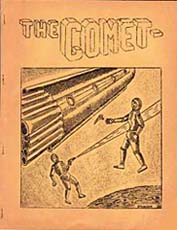Difference between revisions of "The Comet"
Drew morse (talk | contribs) |
Drew morse (talk | contribs) m |
||
| Line 2: | Line 2: | ||
'''The Comet''' is a fanzine that was published in 1930 in the U.S.A. by Raymond Palmer. | '''The Comet''' is a fanzine that was published in 1930 in the U.S.A. by Raymond Palmer. | ||
| − | ''The Comet'' is widely acknowledged as being the first science fiction fanzine ever published. It was edited by Raymond Arthur Palmer and published by the Science Correspondence Club. As the name of the publishers suggests, it has its origins in correspondence between science fiction fans. Naturally, the letter section of | + | ''The Comet'' is widely acknowledged as being the first science fiction fanzine ever published. It was edited by Raymond Arthur Palmer and published by the Science Correspondence Club. As the name of the publishers suggests, it has its origins in correspondence between science fiction fans. Naturally, the letter section of ''The Comet'' was a prominent feature of the zine, where readers discussed issues concerning science, science fiction and fiction. |
Contributors to this first issue, dated May 1930, included [[Lilith Lorraine]], among others. | Contributors to this first issue, dated May 1930, included [[Lilith Lorraine]], among others. | ||
Revision as of 19:48, 14 July 2012
The Comet is a fanzine that was published in 1930 in the U.S.A. by Raymond Palmer.
The Comet is widely acknowledged as being the first science fiction fanzine ever published. It was edited by Raymond Arthur Palmer and published by the Science Correspondence Club. As the name of the publishers suggests, it has its origins in correspondence between science fiction fans. Naturally, the letter section of The Comet was a prominent feature of the zine, where readers discussed issues concerning science, science fiction and fiction.
Contributors to this first issue, dated May 1930, included Lilith Lorraine, among others.
After the first issue, the title changed to Science Correspondence Club Organ for the second and third issue. The fourth issue was titled Science Correspondence Club Bulletin. After the fourth issue (September 1930), A.W. Gowing assumed editorship, and changed the title to Cosmology, the title it retained until the seventeenth and final issue (1933). Editorship changed hands once again, though, for the final four issues, to Aubrey McDermott and Clifton Amsbury.
Other science fiction zines following in the wake of The Comet included The Time Traveller and Science Fiction, edited by Jerome Siegal, one of the creators of Superman.
Raymond Palmer went on to edit Amazing Stories and Fantastic Adventures and a number of other magazines issued by his own publishing company.
